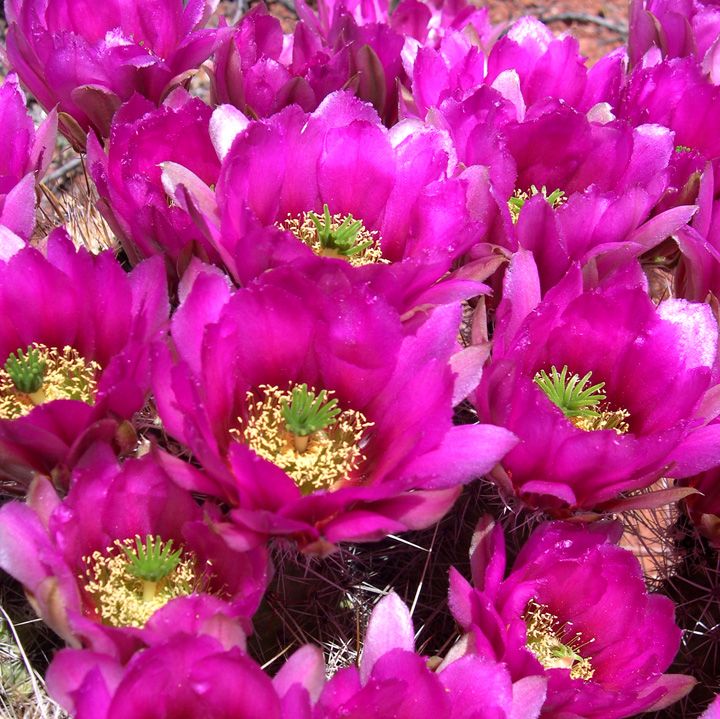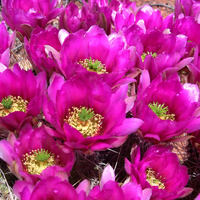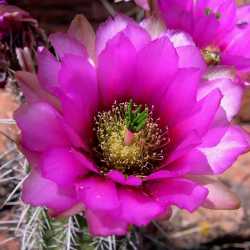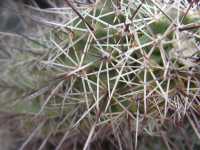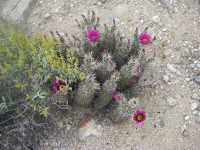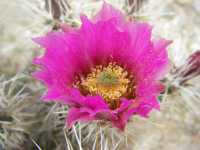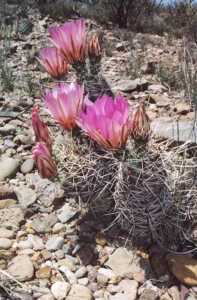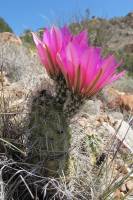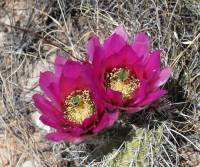Plants 5-30-branched, forming somewhat open clumps. Stems mostly erect, cylindric, (5-)10-40 × 4.5-8 cm; ribs 10-15, crests slightly undulate; areoles 10-15 mm apart. Spines 8-16 per areole, usually straight, individual spines with broad zones of different colors: yellowish, reddish brown, or gray to black, or white to black, becoming gray; radial spines 7-15 per areole, 5-15 mm; central spines 1-3 per areole, divergent-porrect, 15-75 mm, all terete. Flowers 6-10 × 8-10 cm; flower tube 10-20 × 15-40 mm; flower tube hairs 2.3-4 mm; inner tepals rose-pink to magenta [rarely nearly white], with midstripes darker, darker magenta or sometimes purplish maroon near base, (20-)35-52 × 12-20 mm, tips relatively thin and delicate; anthers yellow; nectar chamber 3.3-5 mm. Fruits bright red or orange-red, 20-30 mm, pulp white or sometimes pink. 2n = 44.
Flowering Mar-Jun; fruiting May-Jul. Sonoran Desert, flats to steep canyonsides, desert scrub, semidesert grasslands, interior chaparral; [30-]600-1000(-1500) m; Ariz.; Mexico (Sonora).
New Mexico records of Echinocereus fasciculatus are at least in part based on vigorous old plants of E. fendleri, which sometimes have 1-2 short supplementary central spines (and which appear very different from younger plants in the same populations). Echinocereus fasciculatus may prove to intergrade clinally with E. engelmannii var. acicularis wherever their geographic ranges approach each other. At its upper altitudinal limit, E. fasciculatus tends to have shorter spines, fewer central spines, shorter stems, and more compact growth habit.
Common Name: pinkflower hedgehog cactus
Duration: Perennial
Protected Status: Salvage restriced status in Arizona.
General: Stems of mature plants mostly erect with 3-20 stems in somewhat open clumps, the larger stems green and cylindroid, elongate and 16-30 cm long by 4-7.5 cm diameter with slightly undulate crests and 8-18 ribs. Not markedly tuberculate and the areoles not bearing white felt at maturity, these circular and typically 10-15 mm apart with the spines not obliterating stem surface.
Spines: Generally 8-16 spines per areole that are usually straight and extended forward with 15-75 mm central spines that are pale gray with brown or black tips or straw colored, white, light brown, or reddish-brown, usually 1-3 per areole, the principal central spine is the most prominent, either spreading or deflexed but straight and accompanied by 1-2 or even 3 short accessory central spines. The radial spines are usually white or pale gray but sometimes yellow or like the central spine, 5-15 mm long with 7-15 per areole.
Flowers: Tepals are magenta to reddish-purple but rarely nearly white, with mid-stripes that are a darker magenta or sometimes purplish-maroon near the base with a flower tube 10-20 mm long by 15-40 mm wide, usually elliptic to wedge shaped.
Fruits: Fruit bright red, orange-red, or greenish when young generally 20-30 mm long and 12-25 mm diameter with pulp that is white or sometimes pink.
Ecology: Found in the Sonoran desert on flats to steep canyon sides, desert scrub, semi-desert grasslands, interior chaparral, from 2,500-5,000 ft (762-1524 m), flowers March-June, fruiting May-July.
Notes: This species has larger and more numerous stems than E. fendleri and often appears as a large clump when seed from a distance in open areas. E. fasciculatus used to contain two varieties, E. fasciculatus var. boyce-thompsonii, and E. fasciculatus var. bonkerae that are now considered separate species by USDA Plants. ITIS shows E. fasciculatus to be unaccepted as a stand alone species and instead counts it as E. fendleri var. fasciculatus, although USDA Plants accepts E. fasciculatus as a species. While TROPICOS places this species as E. fendleri var. fasciculatus.
Ethnobotany: No specific use of the species recorded, however the fruits of the genus were used as food.
Synonyms: Many, see Tropicos
Editor: LCrumbacher, 2010


